Coding Notes
Table of Contents
"Lot of Some daily routines"
Heatmap
Heatmap displays pair-wise test result. Depth of entry is test statistics, stars represent significance.
# load packages
libs <- c("dplyr", "data.table", "ggplot2")
lapply(libs, require, character.only = TRUE)
options(stringsAsFactors = F)
# demo data
mat <- read.csv("https://zhanghaoyang.net/note/heatmap/mat.csv") # statistics matrix
mat_p <- read.csv("https://zhanghaoyang.net/note/heatmap/mat_p.csv") # p value matrix
# reshape
df1 <- melt(setDT(mat), id.vars = c("from"), variable.name = "to")
df2 <- melt(setDT(mat_p), id.vars = c("from"), variable.name = "to", value.name='symbol')
df2 <- df2 %>% mutate(symbol = ifelse(symbol < 0.001, "***", ifelse(symbol < 0.01, "**", ifelse(symbol < 0.05, "*", ""))))
df <- df1%>%merge(df2, by=c('from', 'to'))
# plot
p <- df %>% ggplot(aes(from, to, fill = value, label = symbol)) +
geom_tile(color = "white", linewidth = 1) +
scale_fill_gradient2(limits = c(0, 1)) +
theme_classic() +
theme(
axis.text.x = element_text(angle = 90, vjust = 0.5, hjust = 1, color = "black"),
axis.text.y = element_text(color = "black"),
legend.title = element_text(size = 12), legend.text = element_text(size = 8), legend.key.size = unit(1, "cm"),
plot.title = element_text(size = 12, face = "bold", hjust = 0.5, margin = margin(b = -10))
) +
scale_fill_distiller(palette = "Spectral") +
labs(x = "From", y = "To", fill = "statistics", subtitle = "") +
geom_text(color = "#000000", size = 4, hjust = 0.5, vjust = 0.5)
# save
png("heatmap.png", width = 500, height = 400, res = 100)
print(p)
dev.off()
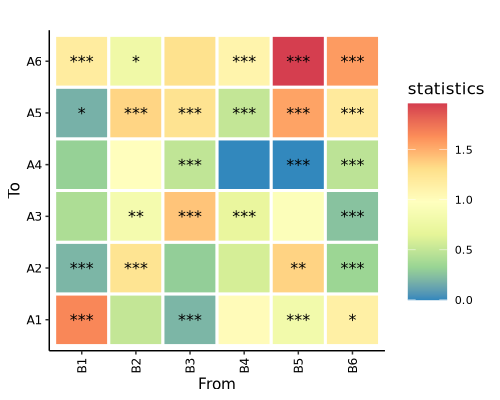 Environment (not necessarily the same, please check if there are any errors):
Environment (not necessarily the same, please check if there are any errors):
# r_version = gsub('version ', '', strsplit(unlist(R.version['version.string']), ' \\(')[[1]][1])
# session = c()
# for (lib in libs) {session = c(session, sprintf('%s: %s', lib, packageVersion(lib)))}
# session = paste(session, collapse=', ')
# paste0(r_version, ', with ', session)
# "R 4.3.2, with dplyr: 1.1.4, data.table: 1.14.10, ggplot2: 3.5.0"
Barplot
Barplot displays mean difference of two groups.
# load packages
libs <- c("dplyr", "ggplot2")
lapply(libs, require, character.only = TRUE)
# demo data
df <- read.csv("https://zhanghaoyang.net/note/bar/bar.csv")
df <- df%>%group_by(group1) %>% mutate(symbol = ifelse(value == max(value), symbol, ""))
# plot
p <- ggplot(df, aes(x = group1, y = value, fill = group2)) +
geom_bar(stat = "identity", position = "dodge", width = 0.7, color = "black") +
geom_text(aes(label = symbol), color = "#000000", vjust = -0.5, size = 4, fontface = "bold") +
ylim(0, 0.4) +
labs(title = "Difference between cafe and tea", x = "Group 1", y = "Value") +
theme_classic() +
theme(
legend.position = c(0.9, 0.9),
legend.title = element_blank(),
legend.background = element_rect(fill = "white"),
plot.title = element_text(face = "bold", hjust = 0.5),
axis.title = element_text(face = "bold"),
)
# save
png("bar.png", width=600, height=600, res=130)
p
dev.off()
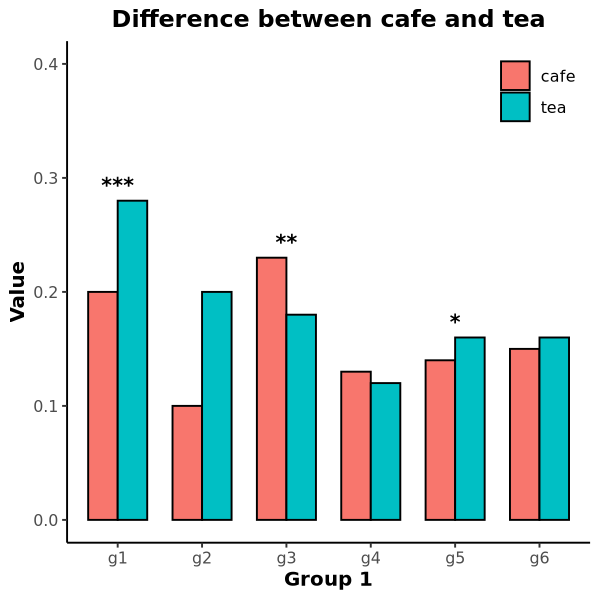 Stacked barplot displays proportion, Reference.
Stacked barplot displays proportion, Reference.
# load packages
libs <- c("dplyr", "ggplot2", "ggpubr", "ggsci")
lapply(libs, require, character.only = TRUE)
# demo data
df <- read.csv("https://zhanghaoyang.net/note/bar/stacked_bar.csv")
df <- df%>%mutate(score=factor(score, levels=c('Severe', 'Moderate', 'Mild', 'Absent'))) # set levels
# plot
plots <- list()
for (syndrome in unique(df$syndrome)) {
df1 <- df %>% filter(syndrome == !!syndrome)
p <- ggplot(df1, aes(x = symptom, weight = prop, fill = score)) +
geom_bar(position = "stack") +
coord_flip() +
labs(x = "", y = "", fill = "", title = syndrome, subtitle = "") +
theme(axis.text.x = element_text(angle = 90, vjust = 0.5, hjust = 1, color = "black"),
axis.text.y = element_text(color = "black"), legend.position = "none") +
theme(plot.title = element_text(size = 15, face = "bold", hjust = 0.5, vjust=-5)) +
scale_fill_nejm()
plots[[syndrome]] <- p
}
# combine and save
png("./stacked_bar.png", height = 1000, width = 1000, res = 160)
do.call(ggarrange, c(plots, ncol = 2, nrow = 2, common.legend = T, legend = "bottom", hjust = 0.1, vjust = 0.1))
dev.off()
 Environment:
Environment:
R 4.3.2, with dplyr: 1.1.4, ggplot2: 3.5.0, ggpubr: 0.6.0, ggsci: 3.0.0
Histogram
Histogram displays trend, data from this paper, code from this paper.
# load packages
libs <- c("ggplot2")
lapply(libs, require, character.only = TRUE)
# demo data
df <- read.csv("https://zhanghaoyang.net/note/hist/hist.csv")
outcome <- "gest"; var <- "p3_SO2_24h"
# process
start <- round(min(df[, var]), 1)
end <- round(max(df[, var]), 1)
newx <- seq(start, end, by = (end - start) / 20)
df_p <- as.data.frame(table(cut(df[, var], breaks = newx, include.lowest = T), df[, outcome]))
colnames(df_p) <- c("range", "type", "count")
df_p$type <- ifelse(df_p$type == 1, "Case", "Non-case")
# plot
p <- ggplot(df_p) +
geom_col(aes(x = range, y = count, fill = type)) +
scale_fill_manual(values = c("#ce2f13", "#19e7dd")) +
labs(title = "", x = "Dose of Exposure", y = "Number of Case") +
theme_classic() +
theme(
legend.position = c(0.8, 0.8),
legend.title = element_blank(),
legend.background = element_rect(fill = "white"),
axis.text.x = element_text(angle = 90, hjust = 1),
axis.title = element_text(face = "bold"),
)
# save
png("hist.png", width = 600, height = 600, res = 130)
p
dev.off()
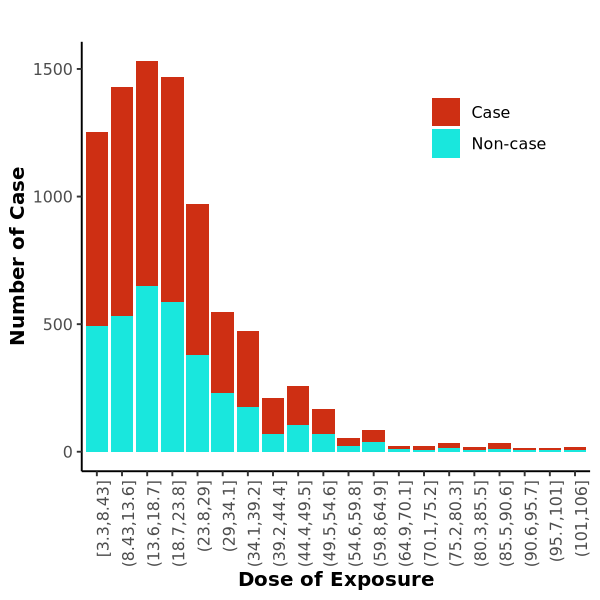 Environment:
Environment:
R 4.3.2, with ggplot2: 3.5.0
Forest plot
Forest plot displays effect size, Reference.
# load packages
libs <- c("forestplot", "dplyr")
lapply(libs, require, character.only = TRUE)
# demo data
df <- read.csv("https://zhanghaoyang.net/note/forest/forest.csv")
df <- df %>% mutate(effect = sprintf("%.2f±%.2f", beta, se)) # use in plot1
df <- df %>% mutate(labeltext = group1, mean = beta, lower = beta - 1.96 * se, upper = beta + 1.96 * se) # rename to fit default parameters of forestplot
# plot
png("forest1.png", width = 800, height = 600, res = 140)
df %>%forestplot(
labeltext = c(group1, group2, effect),
boxsize = .25, line.margin = .1, clip = c(-1, 1),
xlab = "Effect size") %>%
fp_add_header(group1 = c("Group1"), group2 = c("Group2"), effect = c("Effect")) %>%
fp_set_zebra_style("#F5F9F9")
dev.off()
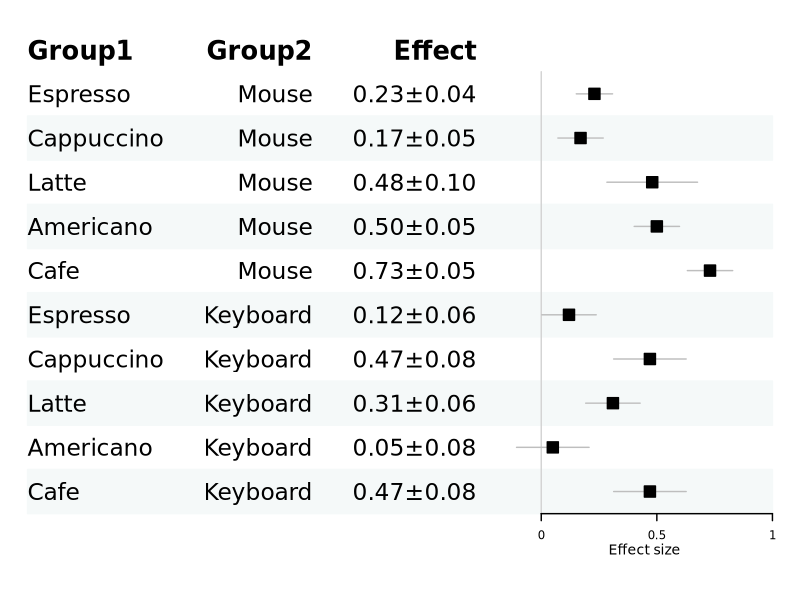 Grouped plot
Grouped plot
png("forest2.png", width = 600, height = 500, res = 140)
df %>% group_by(group2) %>%
forestplot(
boxsize = .25, line.margin = .1, clip = c(-1, 1),
xlab = "Effect size",
legend_args = fpLegend(pos = list(x = .85, y = 0.85), gp = gpar(col = "#CCCCCC", fill = "#F9F9F9"))) %>%
fp_set_style(box = c("blue", "darkred") %>% lapply(function(x) gpar(fill = x, col = "#555555")),default = gpar(vertices = TRUE)) %>%
fp_add_header(labeltext = c("Group")) %>%
fp_set_zebra_style("#F5F9F9")
dev.off()
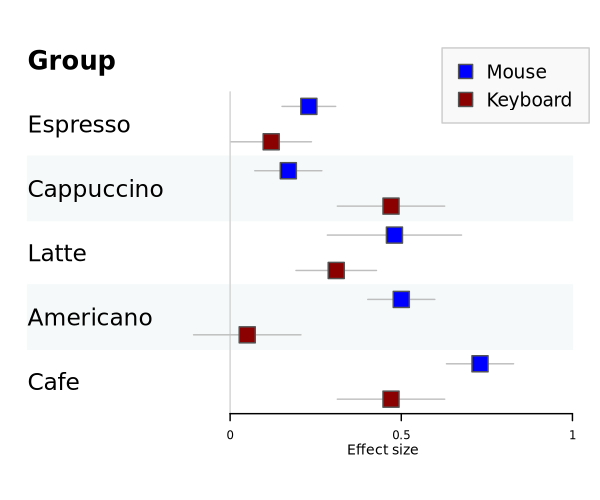 Environment:
Environment:
R 4.3.2, with forestplot: 3.1.3, dplyr: 1.1.4
Line plot
Line plot displays time series, Reference.
# load packages
libs = c('dplyr', 'ggplot2')
lapply(libs, require, character.only = TRUE)
# demo data
df <- read.csv('https://zhanghaoyang.net/note/line/line.csv')
df$DT <- as.Date(df$DT)
# plot
p <- ggplot(df, aes(x = DT, y = num, group = group)) +
geom_point(aes(color = group)) + geom_line(aes(color = group)) +
scale_x_date(date_labels = "%m-%d") + ylim(0, 6500) +
labs(x = "Date", y = "Number", color = "Attending department", title='Patient visit') +
theme_bw() +
theme(
legend.position = c(0.23, 0.85),
legend.title = element_blank(), legend.background = element_rect(fill = "white"),
plot.title = element_text(face = "bold", hjust = 0.5),
axis.title = element_text(face = "bold"),
panel.grid.major = element_blank(), panel.grid.minor = element_blank()
) +
geom_vline(xintercept = as.Date(c("2022-12-01", "2022-12-15", "2022-12-29")), linetype = "dashed", color = "gray", size = 1) +
geom_text(aes(x = as.Date("2022-12-14"), y = 6000), label = "Before After")
# save
png("line.png", height = 800, width = 800, res = 150)
print(p)
dev.off()
 Environment:
Environment:
R 4.3.2, with dplyr: 1.1.4, ggplot2: 3.5.0
Venn plot
Venn plot displays relationships between different sets of data.
# load packages
libs <- c("VennDiagram", "RColorBrewer")
lapply(libs, require, character.only = TRUE)
# demo data
set.seed(111)
set1 <- paste("type_", sample(1:100, 50))
set2 <- paste("type_", sample(1:100, 50))
set3 <- paste("type_", sample(1:100, 20))
# plot
venn.diagram(
x = list(set1, set2, set3),
category.names = c("cafe", "tea", "water"),
lwd = 2, lty = "blank", fill = brewer.pal(3, "Pastel2"), # circle option
cex = .6, fontface = "bold", fontfamily = "sans", # number option
cat.cex = 0.6, cat.fontface = "bold", cat.default.pos = "outer",cat.fontfamily = "sans", rotation = 1, # set names option
output = TRUE, disable.logging = T, filename = "venn.png", imagetype = "png", height = 400, width = 400, resolution = 250, # output image option
)
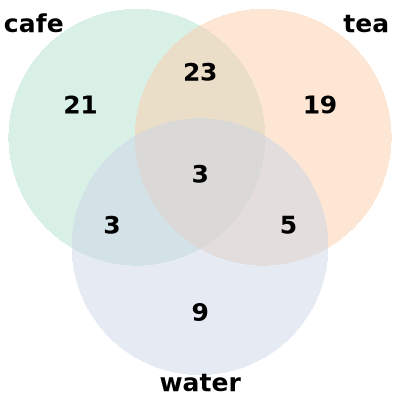 Environment:
Environment:
R 4.3.2, with VennDiagram: 1.7.3, RColorBrewer: 1.1.3
Volcano plot
Volcano plot displays differential expression.
# load packages
libs <- c("dplyr", "ggplot2", "ggrepel")
lapply(libs, require, character.only = TRUE)
options(stringsAsFactors = F)
# demo data
df <- read.csv("https://zhanghaoyang.net/note/volcano/volcano.csv")
df <- df %>%
arrange(p) %>%
na.omit()
# plot options
pvalue_cutoff <- 0.05 # threshold of p
logFC_cutoff <- 0.4 # threshold of logFc
labelnum <- 5 # number of gene to marked
# plot
df$diff <- ifelse(df$p < pvalue_cutoff & abs(df$log2fc) >= logFC_cutoff, ifelse(df$log2fc > logFC_cutoff, "Up", "Down"), "Stable")
label_data <- filter(df, ((df$p < pvalue_cutoff) & (abs(df$log2fc) >= logFC_cutoff)))[1:labelnum, ]
p <- ggplot(df, aes(x = log2fc, y = -log10(p), colour = diff)) +
geom_point(data = df, aes(x = log2fc, y = -log10(p), colour = diff), size = 1, alpha = 1) +
scale_color_manual(values = c("blue", "gray", "red")) +
geom_vline(xintercept = c(-1, 1), lty = 4, col = "black", lwd = 0.5) +
geom_hline(yintercept = -log10(pvalue_cutoff), lty = 4, col = "black", lwd = 0.5) +
geom_label_repel(data = label_data, size = 1.8, aes(label = gene), show.legend = FALSE) +
theme_bw() +
theme(legend.position = "right", panel.grid = element_blank(), legend.title = element_blank(), legend.text = element_text(face = "bold")) +
labs(x = "log2 (fold change)", y = "-log10 (p-value)", title = NULL)
# save
png("volcano.png", width = 1000, height = 600, res = 180)
print(p)
dev.off()
 Environment:
Environment:
R 4.3.2, with dplyr: 1.1.4, ggplot2: 3.5.0, ggrepel: 0.9.5
Manhattan plot
Manhattan plot displays GWAS effect. First, download demo data (T2D GWAS, form Biobank Japan):wget -c https://zhanghaoyang.net/note/ldsc/trait1.txt.gzThen, plot in R:
# load packages
libs <- c("dplyr", "ggrepel")
lapply(libs, require, character.only = TRUE)
# demo data
df <- read.delim("trait1.txt.gz")
# optional, filter very non-sig snps to speed up the plot
df <- df %>% filter(-log10(P) > 1)
# select your highlight snp, and p threshold
annotate_snp <- df[order(df$P), "SNP"][1:10] # snp to highlight
highlight_pthres = 5e-8 # p threshold for highlight
# process data
df_p <- df %>%
group_by(CHR) %>%summarise(chr_len = max(POS))%>%mutate(tot = cumsum(as.numeric(chr_len)) - chr_len) %>%select(-chr_len) %>% # cumulative position for chr
left_join(df, ., by = c("CHR" = "CHR")) %>%arrange(CHR, POS) %>%mutate(POScum = POS + tot) %>% # cumulative position for snp
mutate(is_highlight = ifelse(P < highlight_pthres, "yes", "no")) %>% # highlight snp with colour
mutate(is_annotate = ifelse(SNP %in% annotate_snp, "yes", "no")) # annotate snp with text
# x axis datas
axisdf <- df_p %>%group_by(CHR) %>%summarize(center = (max(POScum) + min(POScum)) / 2)
# plot
p <- ggplot(df_p, aes(x = POScum, y = -log10(P))) +
geom_point(aes(color = as.factor(CHR)), alpha = 0.8, size = 0.8) +
geom_point(data = subset(df_p, is_highlight == "yes"), color = "#1423f8", size = 0.8) +
geom_label_repel(data = subset(df_p, is_annotate == "yes"), aes(label = SNP), size = 2) +
scale_color_manual(values = rep(c("grey", "black"), 22)) +
scale_x_continuous(label = axisdf$CHR, breaks = axisdf$center) + scale_y_continuous(expand = c(0, 0)) +
labs(x = "Chromosome", y = "-Log10(P) of GWAS effect") +
ylim(0, max(-log10(df_p$P))*1.1) +
theme_bw() + theme(legend.position = "none", panel.grid.major.x = element_blank(), panel.grid.minor.x = element_blank(), axis.text.x = element_text(angle = 75, hjust = 1))
png("manhattan.png", width = 1200, height = 600, res = 150)
p
dev.off()
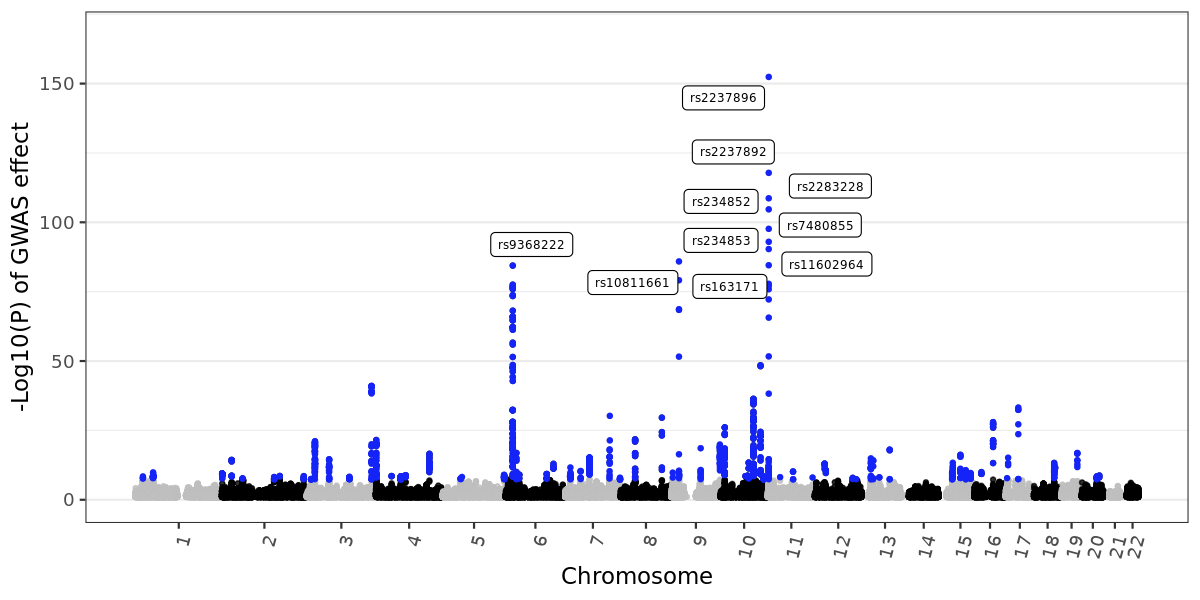 Environment:
Environment:
R 4.2.3, with dplyr: 1.1.4, ggrepel: 0.9.4
GWAS
GWAS measures genetic effect on a trait. Here we do with Plink. Reference genome from 1000G. The demo is in hg19.# download plink wget -c https://s3.amazonaws.com/plink1-assets/plink_linux_x86_64_20231211.zip unzip plink_linux_x86_64_20231211.zip # download referene genome wget -c https://zhanghaoyang.net/db/1000g_bfile_hg19.tar.gz tar -xvf 1000g_bfile_hg19.tar.gz # download demo pheno with covar and pc. wget -c https://zhanghaoyang.net/note/gwas/pheno.txt # gwas file_pheno="pheno.txt" file_bfile="1000g_bfile_hg19/eas" # For EAS. If you study EUR, use 'eur' ./plink \ --allow-no-sex \ --bfile $file_bfile \ --pheno $file_pheno --pheno-name outcome \ --covar $file_pheno --covar-name pc1,pc2,pc3,pc4,pc5,covar1,covar2 \ --linear hide-covar \ --out gwas_linear # result like: # CHR SNP BP A1 TEST NMISS BETA STAT P # 1 rs575272151 11008 G ADD 479 -0.5081 -0.254 0.7996 # 1 rs544419019 11012 G ADD 479 -0.5081 -0.254 0.7996 # 1 rs62635286 13116 G ADD 479 -2.675 -1.125 0.2611 # 1 rs200579949 13118 G ADD 479 -2.675 -1.125 0.2611 # ...
MTAG (Multi-Trait Analysis of GWAS)
MTAG perform meta-analysis on multiple GWAS. The demo is in hg19.
# download mtag
git clone https://github.com/omeed-maghzian/mtag.git
cd mtag
# download ldscore
wget -c https://zhanghaoyang.net/db/1000g_ldscore_hg19.tar.gz # ldscore
tar -xvf 1000g_ldscore_hg19.tar.gz
# download demo data
mkdir demo
wget -c -P demo https://zhanghaoyang.net/note/ldsc/trait1.txt.gz # bbj t2d
wget -c -P demo https://zhanghaoyang.net/note/ldsc/trait2.txt.gz # bbj cataract
# calculate Z value
zcat demo/trait1.txt.gz | awk 'BEGIN {OFS="\t"} NR==1 {print $0, "Z"} NR>1 {print $0, $7/$8}' > demo/trait1_formtag.txt
zcat demo/trait2.txt.gz | awk 'BEGIN {OFS="\t"} NR==1 {print $0, "Z"} NR>1 {print $0, $7/$8}' > demo/trait2_formtag.txt
# run mtag
file_gwas1="demo/trait1_formtag.txt"
file_gwas2="demo/trait2_formtag.txt"
file_out="demo/meta"
./mtag.py \
--ld_ref_panel 1000g_ldscore_hg19/eas_ldscores/ \
--sumstats $file_gwas1,$file_gwas2 --out $file_out \
--snp_name SNP --a1_name A1 --a2_name A2 --eaf_name FRQ --beta_name BETA --se_name SE --n_name N --p_name P --chr_name CHR --bpos_name POS --z_name Z \
--equal_h2 --perfect_gencov --n_min 0.0 \
--stream_stdout
# result
# SNP CHR BP A1 A2 meta_freq mtag_beta mtag_se mtag_z mtag_pval
# rs3094315 1 752566 A G 0.8425 -0.005299401523127379 0.003412792034976138 -1.5528052892811066 0.12046965870267985
# rs1048488 1 760912 T C 0.8425 -0.005230848191213525 0.003412792034976138 -1.5327181198282709 0.12534532263533132
# ...
Environment:
Python 2.7, with numpy (>=1.13.1), numpy (>=1.13.1), pandas (>=0.18.1), scipy, argparse, bitarray, joblib
Genetic correlation
LDSC (LD Score Regression)
LDSC measures heritability, and genetic correlation based on GWAS summary. Demo data is type 2 diabetes (trait1) and cataract (trait2), from Biobank Japan. The analysis is presented in this paper. The demo is in hg19.# install git clone https://github.com/bulik/ldsc.git cd ldsc conda env create --file environment.yml conda activate ldsc # download ld score and snplist wget -c https://zhanghaoyang.net/db/1000g_ldscore_hg19.tar.gz # ldscore wget -c https://zhanghaoyang.net/db/w_hm3.snplist # snp list for munge tar -xvf 1000g_ldscore_hg19.tar.gz # download demo data mkdir demo wget -c -P demo https://zhanghaoyang.net/note/ldsc/trait1.txt.gz # bbj t2d wget -c -P demo https://zhanghaoyang.net/note/ldsc/trait2.txt.gz # bbj cataract # munge and heritability path_ld="1000g_ldscore_hg19/eas_ldscores/" # for eas, if your population is eur, use 'eur_w_ld_chr' for trait in trait1 trait2 do # munge ./munge_sumstats.py \ --sumstats demo/$trait.txt.gz \ --out demo/$trait \ --merge-alleles w_hm3.snplist # single trait heritability ./ldsc.py \ --h2 demo/$trait.sumstats.gz \ --ref-ld-chr $path_ld \ --w-ld-chr $path_ld \ --out demo/$trait done # cross trait genetic correlation ./ldsc.py \ --rg demo/trait1.sumstats.gz,demo/trait2.sumstats.gz \ --ref-ld-chr $path_ld \ --w-ld-chr $path_ld \ --out demo/trait1_AND_trait2 # result: # Heritability of phenotype 1 # --------------------------- # Total Observed scale h2: 0.0973 (0.0088) # Lambda GC: 1.3443 # Mean Chi^2: 1.5112 # Intercept: 1.1209 (0.0253) # Ratio: 0.2365 (0.0495) # Heritability of phenotype 2/2 # ----------------------------- # Total Observed scale h2: 0.0064 (0.0023) # Lambda GC: 1.0802 # Mean Chi^2: 1.0824 # Intercept: 1.0532 (0.0081) # Ratio: 0.6454 (0.0979) # Genetic Covariance # ------------------ # Total Observed scale gencov: 0.0143 (0.0025) # Mean z1*z2: 0.1518 # Intercept: 0.0918 (0.0066) # Genetic Correlation # ------------------- # Genetic Correlation: 0.5731 (0.1263) # Z-score: 4.5377 # P: 5.6861e-06
HDL (High-Definition Likelihood)
HDL to measure heritability, and genetic correlation based on GWAS summary.Install, download ref panel, process GWAS:
# install
git clone https://github.com/zhenin/HDL
cd HDL
Rscript HDL.install.R
# download ref panel
wget -c -t 1 https://www.dropbox.com/s/6js1dzy4tkc3gac/UKB_imputed_SVD_eigen99_extraction.tar.gz?e=2 --no-check-certificate -O ./UKB_imputed_SVD_eigen99_extraction.tar.gz
md5sum UKB_imputed_SVD_eigen99_extraction.tar.gz # b1ba0081dc0f7cbf626c0e711e88a2e9
tar -xzvf UKB_imputed_SVD_eigen99_extraction.tar.gz
# download and process demo gwas
file_gwas1="20002_1223.gwas.imputed_v3.both_sexes.tsv.bgz"
file_gwas2="20022_irnt.gwas.imputed_v3.both_sexes.tsv.bgz"
path_ld="UKB_imputed_SVD_eigen99_extraction"
wget https://www.dropbox.com/s/web7we5ickvradg/${file_gwas1}?dl=0 -O $file_gwas1
wget https://www.dropbox.com/s/web7we5ickvradg/${file_gwas2}?dl=0 -O $file_gwas2
Rscript HDL.data.wrangling.R \
gwas.file=$file_gwas1 LD.path=$path_ld GWAS.type=UKB.Neale \
output.file=gwas1 log.file=gwas1
Rscript HDL.data.wrangling.R \
gwas.file=$file_gwas1 LD.path=$path_ld GWAS.type=UKB.Neale \
output.file=gwas2 log.file=gwas2
Run HDL:
library('HDL')
file_gwas1 <- 'gwas1.hdl.rds'
file_gwas2 <- 'gwas2.hdl.rds'
path_LD <- "UKB_imputed_SVD_eigen99_extraction"
gwas1.df <- readRDS(file_gwas1)
gwas2.df <- readRDS(file_gwas2)
res.HDL <- HDL.rg(gwas1.df, gwas2.df, path_LD)
res.HDL
# result
# $rg
# -0.1898738
# $rg.se
# [1] 0.03584022
# $P
# 1.172153e-07
# $estimates.df
# Estimate se
# Heritability_1 0.009952692 0.0009098752
# Heritability_2 0.124093170 0.0053673821
# Genetic_Covariance -0.006672818 0.0011499116
# Genetic_Correlation -0.189873814 0.0358402203
Environment:
R 4.3.2, with HDL: 1.4.0
LAVA (Local Analysis of Variant Association)
LAVA measures local heritability and local genetic correlation. The demo is from their vignettes. Download vignettes:git clone [email protected]:josefin-werme/LAVA.git cd LAVAVignettes:
library(LAVA)
# load demo data
input <- process.input(
input.info.file = "vignettes/data/input.info.txt", # input info file
sample.overlap.file = "vignettes/data/sample.overlap.txt", # sample overlap file (can be set to NULL if there is no overlap)
ref.prefix = "vignettes/data/g1000_test", # reference genotype data prefix
phenos = c("depression", "neuro", "bmi")
) # subset of phenotypes listed in the input info file that we want to process
# load locus
loci <- read.loci("vignettes/data/test.loci")
locus <- process.locus(loci[1, ], input)
# calculate local h2 and rg
run.univ.bivar(locus)
# result
# $univ
# phen h2.obs p
# 1 depression 8.05125e-05 0.04240950
# 2 neuro 1.16406e-04 0.03154340
# 3 bmi 1.93535e-04 0.00146622
# $bivar
# phen1 phen2 rho rho.lower rho.upper r2 r2.lower r2.upper p
# 1 depression neuro -0.262831 -1 0.57556 0.0690801 0 1 0.559251
# 2 depression bmi -0.425955 -1 0.32220 0.1814380 0 1 0.229193
# 3 neuro bmi -0.463308 -1 0.23535 0.2146540 0 1 0.176355
# calculate partial correlation
run.pcor(locus, target = c("depression", "neuro"), phenos = "bmi")
# result
# phen1 phen2 z r2.phen1_z r2.phen2_z pcor ci.lower ci.upper p
# 1 depression neuro bmi 0.181438 0.214654 -0.573945 -1 0.63279 0.382796
Environment:
R 4.3.3, with LAVA: 0.1.0
GPA (Genetic analysis incorporating Pleiotropy and Annotation)
GPA to explore overall genetic overlap. Download demo data:wget -c https://zhanghaoyang.net/note/ldsc/trait1.txt.gz # bbj t2d wget -c https://zhanghaoyang.net/note/ldsc/trait2.txt.gz # bbj cataractPerform GPA:
libs <- c("GPA", "dplyr")
lapply(libs, require, character.only = TRUE)
file1 <- 'trait1.txt.gz'
file2 <- 'trait2.txt.gz'
df1 <- read.table(file1,header=T)%>%select('SNP', 'P')
df2 <- read.table(file2,header=T)%>%select('SNP', 'P')
df <- inner_join(df1,df2,by='SNP')
fit.GPA.noAnn <- GPA(df[,2:3],NULL)
fit.GPA.pleiotropy.H0 <- GPA(df[,2:3], NULL, pleiotropyH0=TRUE)
test.GPA.pleiotropy <- pTest(fit.GPA.noAnn, fit.GPA.pleiotropy.H0)
test.GPA.pleiotropy
# result
# test.GPA.pleiotropy
# $pi
# 00 10 01 11
# 0.74453733 0.05746187 0.07997989 0.11802092
# $piSE
# pi_10 pi_01 pi_11
# 0.007675531 0.009189753 0.007714982 0.009205299
# $statistics
# iteration_2000
# 599.3845
# $pvalue
# iteration_2000
# 2.278621e-132
Environment:
R 4.2.3, with GPA: 1.10.0, dplyr: 1.1.4
Genetic causality
MR (Mendelian randomization)
Six MR methods (IVW, MR-Egger, weighted median, weighted mode, GSMR, MRlap) to measure causal relationship between two traits.Multivariable MR (MVMR) to consider multiple exposures and mediational effect.
Reference: TwoSampleMR (4 MR methods [IVW, Egger, weighted median, weighted mode], and MVMR), GSMR, MRlap.
Download ref genome, LD score (for MRlap), and demo GWAS data (in hg 19):
# download demo data wget -c https://zhanghaoyang.net/note/ldsc/trait1.txt.gz # bbj t2d, exposure wget -c https://zhanghaoyang.net/note/ldsc/trait2.txt.gz # bbj cataract, outcome wget -c https://zhanghaoyang.net/note/ldsc/trait3.txt.gz # bbj bmi, another exposure (used in mvmr) # download referene genome wget -c https://zhanghaoyang.net/db/1000g_bfile_hg19.tar.gz tar -xvf 1000g_bfile_hg19.tar.gz # download ld score and snplist (used for MRlap) wget -c https://zhanghaoyang.net/db/1000g_ldscore_hg19.tar.gz # ldscore wget -c https://zhanghaoyang.net/db/w_hm3.snplist tar -xvf 1000g_ldscore_hg19.tar.gzUse plink 1.9 to clump, make LD matrix (for GSMR):
# prepare for clump
zcat trait1.txt.gz | awk 'NR==1 {print $0} $9<5e-8 {print $0}' > trait1.forClump
zcat trait1.txt.gz trait3.txt.gz | awk 'NR==1 {print $0} $9<5e-8 {print $0}' > trait1_and_3.forClump # for mvmr
# clump
file_bfile="1000g_bfile_hg19/eas" # hg 19, east asian
plink --allow-no-sex \
--clump trait1.forClump \
--bfile $file_bfile \
--clump-kb 1000 --clump-p1 1.0 --clump-p2 1.0 --clump-r2 0.05 \
--out trait1
plink --allow-no-sex \
--clump trait1_and_3.forClump \
--bfile $file_bfile \
--clump-kb 1000 --clump-p1 1.0 --clump-p2 1.0 --clump-r2 0.05 \
--out trait1_and_3
# extract instrumental variables (iv)
awk 'NR>1 {print $3}' trait1.clumped > trait1.iv
awk 'NR>1 {print $3}' trait1_and_3.clumped > trait1_and_3.iv # for mvmr
# ld mat, used in gsmr
plink --bfile $file_bfile \
--extract trait1.iv \
--r2 square \
--write-snplist \
--out trait1
Perform MR:
# packages
libs <- c("TwoSampleMR", "gsmr", "MRlap", "dplyr", "ggplot2", "ggsci")
lapply(libs, require, character.only = TRUE)
# read gwas
df1_raw <- read.table("trait1.txt.gz", header = 1, sep = "\t")
df2_raw <- read.table("trait2.txt.gz", header = 1, sep = "\t")
snp <- unlist(read.table("trait1.iv"))
# subset iv
df1 <- df1_raw %>% filter(SNP %in% snp) %>% select(-CHR, -POS)
df2 <- df2_raw %>% filter(SNP %in% snp) %>% select(-CHR, -POS)
# harmonise
df1 <- df1 %>%
mutate(id.exposure = "t2d", exposure = "t2d") %>%
rename("pval.exposure" = "P", "effect_allele.exposure" = "A1", "other_allele.exposure" = "A2", "samplesize.exposure" = "N", "beta.exposure" = "BETA", "se.exposure" = "SE", "eaf.exposure" = "FRQ")
df2 <- df2 %>%
mutate(id.outcome = "cataract", outcome = "cataract") %>%
rename("pval.outcome" = "P", "effect_allele.outcome" = "A1", "other_allele.outcome" = "A2", "samplesize.outcome" = "N", "beta.outcome" = "BETA", "se.outcome" = "SE", "eaf.outcome" = "FRQ")
dat <- harmonise_data(df1, df2) %>% filter(mr_keep == T)
# ivw, egger, weighted median, weighted mode
method_list <- c("mr_wald_ratio", "mr_egger_regression", "mr_weighted_median", "mr_ivw", "mr_weighted_mode")
mr_out <- mr(dat, method_list = method_list)
mr_out <- mr_out %>% select(method, nsnp, b, se, pval)
# gsmr
get_gsmr_para <- function(pop = "eas") {
n_ref <<- ifelse(pop == "eas", 481, 489) # Sample size of the 1000g eas (nrow of fam)
gwas_thresh <<- 5e-8 # GWAS threshold to select SNPs as the instruments for the GSMR analysis
single_snp_heidi_thresh <<- 0.01 # p-value threshold for single-SNP-based HEIDI-outlier analysis | default is 0.01
multi_snp_heidi_thresh <<- 0.01 # p-value threshold for multi-SNP-based HEIDI-outlier analysis | default is 0.01
nsnps_thresh <<- 5 # the minimum number of instruments required for the GSMR analysis | default is 10
heidi_outlier_flag <<- T # flag for HEIDI-outlier analysis
ld_r2_thresh <<- 0.05 # LD r2 threshold to remove SNPs in high LD
ld_fdr_thresh <<- 0.05 # FDR threshold to remove the chance correlations between the SNP instruments
gsmr2_beta <<- 1 # 0 - the original HEIDI-outlier method; 1 - the new HEIDI-outlier method that is currently under development | default is 0
}
get_gsmr_para("eas")
ld <- read.table("trait1.ld")
colnames(ld) <- rownames(ld) <- read.table("trait1.snplist")[, 1]
ldrho <- ld[rownames(ld) %in% dat$SNP, colnames(ld) %in% dat$SNP]
snp_coeff_id <- rownames(ldrho)
gsmr_out <- gsmr(dat$beta.exposure, dat$se.exposure, dat$pval.exposure, dat$beta.outcome, dat$se.outcome, dat$pval.outcome,
ldrho, snp_coeff_id, n_ref, heidi_outlier_flag,
gwas_thresh = gwas_thresh, single_snp_heidi_thresh, multi_snp_heidi_thresh, nsnps_thresh, ld_r2_thresh, ld_fdr_thresh, gsmr2_beta
)
gsmr_out <- c("GSMR", length(gsmr_out$used_index), gsmr_out$bxy, gsmr_out$bxy_se, gsmr_out$bxy_pval)
# mrlap
mrlap_out = MRlap(exposure = df1_raw, outcome = df2_raw, exposure_name = "t2d", outcome_name = "cataract", ld = "1000g_ldscore_hg19/eas_ldscores/", hm3 = "w_hm3.snplist")
mrlap_out = c('MRlap', mrlap_out$MRcorrection$m_IVs, mrlap_out$MRcorrection$corrected_effect, mrlap_out$MRcorrection$corrected_effect_se, mrlap_out$MRcorrection$corrected_effect_p)
# merge result
res <- rbind(mr_out, gsmr_out, mrlap_out)
res
# method nsnp b se pval
# MR Egger 91 0.187 0.037 1.85e-06
# Weighted median 91 0.156 0.0230 9.57e-12
# Inverse variance weighted 91 0.174 0.015 2.61e-29
# Weighted mode 91 0.159 0.028 2.37e-07
# GSMR 90 0.172 0.014 1.22e-32
# MRlap 77 0.160 0.015 1.85e-06
Check pleiotropy (intercept in MR-Egger), heterogeneity (Q statistics in IVW and MR-Egger), and weak instruments bias (F statistics):
# pleiotropy
mr_pleiotropy_test(dat)
# id.exposure id.outcome outcome exposure egger_intercept se pval
# t2d cataract cataract t2d -0.001 0.003 0.69
# heterogeneity
mr_heterogeneity(dat)
# id.exposure id.outcome outcome exposure method Q Q_df Q_pval
# t2d cataract cataract t2d MR Egger 106.54 89 0.099
# t2d cataract cataract t2d Inverse variance weighted 106.73 90 0.110
# weak instruments bias
get_f = function(dat){
n = dat$samplesize.exposure[1]
k = nrow(dat)
r = get_r_from_bsen(dat$beta.exposure, dat$se.exposure, dat$samplesize.exposure)
f = (n-k-1)*(sum(r^2))/(1-sum(r^2))/k
return(f)
}
get_f(dat)
# 74.38804
Plot the fitting:
res <- res%>%mutate(b=as.numeric(b))
pleio <- mr_pleiotropy_test(dat)
res$a <- ifelse(res$method=='MR Egger', pleio$egger_intercept, 0) # I only add intercept for MR Egger since other methods have not provided intercepts
p <- ggplot(data = dat, aes(x = beta.exposure, y = beta.outcome)) +
geom_errorbar(aes(ymin = beta.outcome - se.outcome, ymax = beta.outcome + se.outcome), colour = "grey", width = 0) +
geom_errorbarh(aes(xmin = beta.exposure - se.exposure, xmax = beta.exposure + se.exposure), colour = "grey", height = 0) +
geom_point(size = 3, shape = 16, fill = "blue", alpha = 0.6) +
geom_abline(data = res, aes(intercept = a, slope = b, colour = method), show.legend = TRUE) +
labs(colour = "Method", x = "GWAS effect on T2D", y = "GWAS effect on Cataract") +
theme_bw() +
theme(legend.position = c(0.22, 0.83),
legend.title = element_text(size = 11),
legend.text = element_text(size = 10),
panel.background = element_blank(),
axis.text = element_text(size = 12, margin = margin(t = 10, r = 10, b = 10, l = 10)),
axis.title = element_text(size = 14, margin = margin(t = 10, r = 10, b = 10, l = 10))) +
guides(colour = guide_legend(title.position = "top", ncol = 1)) +
scale_fill_nejm()
png("mr_scatter.png")
print(p)
dev.off()
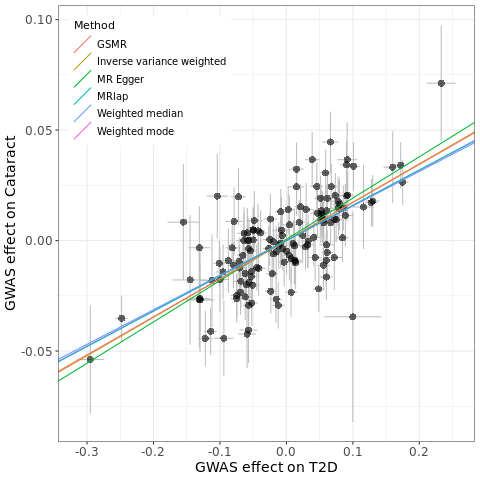 Perform MVMR if interested in mediation:
Perform MVMR if interested in mediation:
# read another exposure and iv for mvmr
df3_raw <- read.table("trait3.txt.gz", header = 1, sep = "\t")
snp_mvmr <- unlist(read.table("trait1_and_3.iv"))
# subset iv
df1 <- df1_raw %>% filter(SNP %in% snp_mvmr) %>% select(-CHR, -POS)
df2 <- df2_raw %>% filter(SNP %in% snp_mvmr) %>% select(-CHR, -POS)
df3 <- df3_raw %>% filter(SNP %in% snp_mvmr) %>% select(-CHR, -POS)
# harmonise
df1 <- df1 %>%
mutate(id.exposure = "t2d", exposure = "t2d") %>%
rename("pval.exposure" = "P", "effect_allele.exposure" = "A1", "other_allele.exposure" = "A2", "samplesize.exposure" = "N", "beta.exposure" = "BETA", "se.exposure" = "SE", "eaf.exposure" = "FRQ")
df3 <- df3 %>%
mutate(id.exposure = "bmi", exposure = "bmi") %>%
rename("pval.exposure" = "P", "effect_allele.exposure" = "A1", "other_allele.exposure" = "A2", "samplesize.exposure" = "N", "beta.exposure" = "BETA", "se.exposure" = "SE", "eaf.exposure" = "FRQ")
df2 <- df2 %>%
mutate(id.outcome = "cataract", outcome = "cataract") %>%
rename("pval.outcome" = "P", "effect_allele.outcome" = "A1", "other_allele.outcome" = "A2", "samplesize.outcome" = "N", "beta.outcome" = "BETA", "se.outcome" = "SE", "eaf.outcome" = "FRQ")
# run mvmr
dat <- harmonise_data(df1, df2) %>% filter(mr_keep == T)
mvdat <- mv_harmonise_data(rbind(df1, df3), df2)
res <- mv_multiple(mvdat)
res
# id.exposure exposure id.outcome outcome nsnp b se pval
# bmi bmi cataract cataract 62 -0.037 0.051 4.748e-01
# t2d t2d cataract cataract 88 0.179 0.016 2.506e-29
Mediation effect = 1 - direct effect (BETA estimated in MVMR) / total effect (BETA estimated in MR). When both total effect and mediated effect align in the same direction, it indicates the presence of a mediating effect.
Environment:
Plink 1.9; R 4.2.3, with TwoSampleMR: 0.5.11, gsmr: 1.1.0, MRlap: 0.0.3.2, dplyr: 1.1.4, ggplot2: 3.5.0, ggsci: 3.0.0
LCV (Latent Causal Variable model)
LCV measures genetic causation based on GWAS summary. Demo data is two munged GWAS summary from above LDSC demo, in hg19. Download script, LD scores, demo data:# lcv script wget -c https://zhanghaoyang.net/note/lcv/RunLCV.R wget -c https://zhanghaoyang.net/note/lcv/MomentFunctions.R # demo sumstats wget -c https://zhanghaoyang.net/note/ldsc/trait1.sumstats.gz # bbj t2d wget -c https://zhanghaoyang.net/note/ldsc/trait2.sumstats.gz # bbj cataract # ld score wget -c https://zhanghaoyang.net/db/1000g_ldscore_hg19.tar.gz # ldscore tar -xvf 1000g_ldscore_hg19.tar.gzPerform LCV:
# source script
source("RunLCV.R")
# load data
file_gwas1 <- "trait1.sumstats.gz"
file_gwas2 <- "trait2.sumstats.gz"
path_ld <- "1000g_ldscore_hg19/eas_ldscores/" # if your population is eur, use 'eur_w_ld_chr'
df1 <- na.omit(read.table("trait1.sumstats.gz", header = TRUE, sep = "\t", stringsAsFactors = FALSE))
df2 <- na.omit(read.table("trait2.sumstats.gz", header = TRUE, sep = "\t", stringsAsFactors = FALSE))
df3 <- data.frame()
for (chr in 1:22) {
file <- paste0(path_ld, chr, ".l2.ldscore.gz")
sub <- read.table(gzfile(file), header = TRUE, sep = "\t", stringsAsFactors = FALSE)
df3 <- rbind(df3, sub)
}
# merge, sort
m <- merge(df3, df1, by = "SNP")
m2 <- merge(m, df2, by = "SNP")
data <- m2[order(m2[, "CHR"], m2[, "BP"]), ]
# qc
mismatch <- which(data$A1.x != data$A1.y, arr.ind = TRUE)
data[mismatch, ]$Z.y <- data[mismatch, ]$Z.y * -1
data[mismatch, ]$A1.y <- data[mismatch, ]$A1.x
data[mismatch, ]$A2.y <- data[mismatch, ]$A2.x
# analysis
LCV <- RunLCV(data$L2, data$Z.x, data$Z.y)
sprintf("Estimated posterior gcp=%.2f(%.2f), log10(p)=%.1f; estimated rho=%.2f(%.2f)", LCV$gcp.pm, LCV$gcp.pse, log(LCV$pval.gcpzero.2tailed) / log(10), LCV$rho.est, LCV$rho.err)
# result
# "Estimated posterior gcp=0.87(0.11), log10(p)=-8.9; estimated rho=0.55(0.12)"
SMR (Summary-data-based Mendelian Randomization)
SMR measures pleiotropic association between the expression and trait with GWAS summary. This demo perform SMR with 49 tissues from GTEx.
# install
wget -c https://yanglab.westlake.edu.cn/software/smr/download/smr-1.3.1-linux-x86_64.zip
unzip smr-1.3.1-linux-x86_64.zip
cd smr-1.3.1-linux-x86_64
# download gtex eqtl
wget --recursive --level=1 --no-parent --accept-regex ".*\.zip" https://yanglab.westlake.edu.cn/data/SMR/GTEx_V8_cis_eqtl_summary.html
mv yanglab.westlake.edu.cn/data/SMR/GTEx_V8_cis_eqtl_summary ./
unzip -o 'GTEx_V8_cis_eqtl_summary/*.zip' -d 'GTEx_V8_cis_eqtl_summary/'
# download referene genome
wget -c https://zhanghaoyang.net/db/1000g_bfile_hg19.tar.gz
tar -xvf 1000g_bfile_hg19.tar.gz
# download demo gwas
wget -c https://zhanghaoyang.net/note/smr/trait4.txt.gz
gzip -d trait4.txt.gz
# run SMR
file_gwas=trait4.txt
path_eqtl="GTEx_V8_cis_eqtl_summary"
path_bfile="1000g_bfile_hg19/eur"
tissues=$(ls $path_eqtl | grep .zip | sed 's/\.zip//g')
for tissue in $tissues
do
file_out="${tissue}_TO_trait4"
if [ -e $file_out.smr ]; then continue; fi
./smr \
--bfile $path_bfile \
--gwas-summary $file_gwas \
--beqtl-summary $path_eqtl/$tissue/$tissue \
--diff-freq-prop 0.2 \
--out $file_out
done
# result (e.g., Lung_TO_trait4.smr ) is like:
# probeID ProbeChr Gene Probe_bp topSNP topSNP_chr topSNP_bp A1 A2 Freq b_GWAS se_GWAS p_GWAS b_eQTL se_eQTL p_eQTL b_SMR se_SMR p_SMR p_HEIDI nsnp_HEIDI
# ENSG00000186891 1 TNFRSF18 1138888 rs6603785 1 1186502 T A 0.113497 0.0471698 0.186186 8.000000e-01 -0.226131 0.0388867 6.058973e-09 -0.208595 0.824138 8.001855e-01 7.833459e-01 3
# ENSG00000176022 1 B3GALT6 1167629 rs6697886 1 1173611 A G 0.128834 0.0459289 0.170633 7.878000e-01 -0.145222 0.0225851 1.276171e-10 -0.316267 1.17601 7.879812e-01 8.766650e-01 4
# ...
Coloc
Coloc performs genetic colocalisation based on GWAS summary. LocusCompareR displays colocalisation. The demo is in hg19.
# load packages
libs <- c("coloc", "locuscomparer")
lapply(libs, require, character.only = TRUE)
# load demo data
file_gwas1 <- "https://zhanghaoyang.net/note/coloc/gwas1.txt"
file_gwas2 <- "https://zhanghaoyang.net/note/coloc/gwas2.txt"
gwas1 <- read.delim(file_gwas1)
gwas2 <- read.delim(file_gwas2)
# prepare list for coloc, we may also use varbeta, which is se^2
D1 <- list(pvalues = gwas1$P, snp = gwas1$SNP, position = gwas1$POS, N = gwas1$N, MAF = gwas1$FRQ)
D2 <- list(pvalues = gwas2$P, snp = gwas2$SNP, position = gwas2$POS, N = gwas2$N, MAF = gwas2$FRQ)
# define 'type' and 's' by your study
D1$type <- "cc"
D2$type <- "cc" # type="cc" for case control or type="quant" for quantitative
D1$s <- 0.33 # only for case control, proportion of cases
D2$s <- 0.33
# coloc analysis
coloc.abf(D1, D2)
# result:
# Posterior
# nsnps H0 H1 H2 H3 H4
# 7.930000e+02 2.757436e-25 1.034489e-13 3.566324e-13 1.329284e-01 8.670716e-01
Plot with locuscomparer:
png("locuscomparer.png", width = 1200, height = 600, res = 150)
locuscompare(
in_fn1 = file_gwas1, in_fn2 = file_gwas2,
marker_col1 = "SNP", pval_col1 = "P", marker_col2 = "SNP", pval_col2 = "P",
title1 = "GWAS1", title2 = "GWAS2"
)
dev.off()
 Environment:
Environment:
R 4.2.3, with coloc: 5.2.3, locuscomparer: 1.0.0"
MAGMA
MAGMA performs gene-based and gene-set analysis based on GWAS summary. Gene set from MsigDB. The demo is in hg19.
# download magma script
wget -c https://zhanghaoyang.net/db/magma_v1.10.zip # mamga script
unzip magma_v1.10.zip
mv README README_magma
# download gene set data
wget -c https://zhanghaoyang.net/db/msigdb_v2023.1.Hs_GMTs.tar.gz
tar -xvf msigdb_v2023.1.Hs_GMTs.tar.gz
# download bfile
wget -c https://zhanghaoyang.net/db/1000g_bfile_hg19.tar.gz
tar -xvf 1000g_bfile_hg19.tar.gz
# download gene pos data
wget -c https://zhanghaoyang.net/db/NCBI37.3.zip
unzip NCBI37.3.zip
# download demo gwas
mkdir demo
wget -c -P demo https://zhanghaoyang.net/note/ldsc/trait1.txt.gz # demo gwas
# magma analysis
file_bfile="1000g_bfile_hg19/eas" # if your data is EUR, use "eur"
file_loc="NCBI37.3.gene.loc"
file_gwas="demo/trait1.txt.gz"; file_pval="demo/pval_file"; file_out="demo/trait1"
N="166718" # sample size
# extract pval
zcat $file_gwas | cut -f 3,9 > $file_pval
# annotate snp
./magma \
--annotate \
--snp-loc $file_bfile.bim \
--gene-loc $file_loc \
--out $file_out
# gene-based analysis
./magma \
--bfile $file_bfile \
--pval $file_pval N=$N \
--gene-annot $file_out.genes.annot \
--out $file_out
# gene-set analysis
path_geneset="msigdb_v2023.1.Hs_GMTs/"
for i in `ls $path_geneset | grep entrez`; do
echo $i
./magma \
--gene-results $file_out.genes.raw \
--set-annot $path_geneset$i \
--out ${file_out}_$i
done
rsidmap
rsidmap finds rsid with genomic position (CHR, POS, A1, A2) from dbsnp. dbsnp is a large dataset cover full snp. Note: if you only work on common variants, you donn't need 'rsidmap', use frq file in 1000 genomics is enough.
# download rsidmap:
git clone https://github.com/zhanghaoyang0/rsidmap.git
cd rsidmap
# download dbsnp:
url="https://ftp.ncbi.nlm.nih.gov/snp/latest_release/VCF/"
dbsnp_hg19="GCF_000001405.25"
dbsnp_hg38="GCF_000001405.40"
# for hg19
wget -c ${url}${dbsnp_hg19}.gz -P dbsnp/
wget -c ${url}${dbsnp_hg19}.gz.md5 -P dbsnp/
wget -c ${url}${dbsnp_hg19}.gz.tbi -P dbsnp/
wget -c ${url}${dbsnp_hg19}.gz.tbi.md5 -P dbsnp/
# for hg38
wget -c ${url}${dbsnp_hg38}.gz -P dbsnp/
wget -c ${url}${dbsnp_hg38}.gz.md5 -P dbsnp/
wget -c ${url}${dbsnp_hg38}.gz.tbi -P dbsnp/
wget -c ${url}${dbsnp_hg38}.gz.tbi.md5 -P dbsnp/
# check md5sum
cd dbsnp
md5sum -c ${dbsnp_hg19}.gz.md5
md5sum -c ${dbsnp_hg19}.gz.tbi.md5
md5sum -c ${dbsnp_hg38}.gz.md5
md5sum -c ${dbsnp_hg38}.gz.tbi.md5
cd ../
# rsidmap:
python ./code/rsidmap_v2.py \
--build hg19 \
--chr_col chr --pos_col pos --ref_col a2 --alt_col a1 \
--file_gwas ./example/largedf_hg19.txt.gz \
--file_out ./example/largedf_hg19_rsidmapv2.txt
# output file is like:
# CHR POS A1 A2 FRQ BETA SE P SNP
# X 393109 T C 0.512 0.131 0.25 0.029 rs1603207647
# 1 10054 C CT 0.2313 0.002 0.23 0.3121 rs1639543820
# 1 10054 CT C 0.1213 0.042 0.12 0.0031 rs1639543798
# Y 10002 T A 0.614 0.28 0.095 0.421 rs1226858834
# ...
Environment:
Python 3.9.6, with numpy: 1.23.1, argparse, gzip, os, time
easylift
easylift made minor efforts on LiftOver to make a lift between hg19 and hg38 easier. It omits laborious steps (i.e., prepare bed input, lift, and then map back to your files).git clone https://github.com/zhanghaoyang0/easylift.git cd easylift # lift can be 'hg19tohg38' or 'hg38tohg19' python ./code/easylift.py \ --lift hg19tohg38 \ --chr_col CHR --pos_col POS \ --file_in ./example/df_hg19.txt.gz \ --file_out ./example/df_hg19_lifted_to_hg38.txt # The output file is like: # CHR POS_old A1 A2 FRQ BETA SE P POS # 2 48543917 A G 0.4673 0.0045 0.0088 0.6101 48316778 # 5 87461867 A G 0.7151 0.0166 0.0096 0.08397 88166050 # 14 98165673 T C 0.1222 -0.0325 0.014 0.02035 97699336 # 12 104289454 T C 0.534 0.0085 0.0088 0.3322 103895676 # 11 26254654 T C 0.0765 0.0338 0.0167 0.04256 26233107 # 4 163471758 T C 0.612 0.0119 0.0094 0.2057 162550606Environment:
LiftOver; Python 3.8, with pandas, argparse, os, sys, time, subprocess
Variant annotation
ANNOVAR
ANNOVAR to annotate genomic variants. First, obtain download link from here, then:# download annovar wget -c http://download_link/annovar.latest.tar.gz tar zxvf annovar.latest.tar.gz cd annovar # download refGene ./annotate_variation.pl -buildver hg38 -downdb -webfrom annovar refGene humandb/ # (Optional) download dbNSFP if you need more information (they are LARGE): ./annotate_variation.pl -buildver hg19 -downdb -webfrom annovar dbnsfp42c humandb/ ./annotate_variation.pl -buildver hg38 -downdb -webfrom annovar dbnsfp42c humandb/ # download demo vcf wget -c https://zhanghaoyang.net/note/anno/demo.vcf # few cases from clinvar, https://ftp.ncbi.nlm.nih.gov/pub/clinvar/vcf_GRCh38/clinvar.vcf.gz # annovar ./table_annovar.pl demo.vcf humandb/ -buildver hg38 -out demo \ -remove -protocol refGene -operation g -nastring . -vcfinput -polish # result cat head demo.hg38_multianno.txt # Chr Start End Ref Alt Func.refGene Gene.refGene GeneDetail.refGene ExonicFunc.refGene AAChange.refGene Otherinfo1 Otherinfo2 Otherinfo3 Otherinfo4 Otherinfo5 Otherinfo6 Otherinfo7 Otherinfo8 Otherinfo9 Otherinfo10 Otherinfo11 # 1 69134 69134 A G exonic OR4F5 . nonsynonymous SNV OR4F5:NM_001005484:exon1:c.A44G:p.E15G . . . 1 69134 2205837 A G . .ALLELEID=2193183;CLNDISDB=MeSH:D030342,MedGen:C0950123;CLNDN=Inborn_genetic_diseases;CLNHGVS=NC_000001.11:g.69134A>G;CLNREVSTAT=criteria_provided,_single_submitter;CLNSIG=Likely_benign;CLNVC=single_nucleotide_variant;CLNVCSO=SO:0001483;GENEINFO=OR4F5:79501;MC=SO:0001583|missense_variant;ORIGIN=1 # 1 69581 69581 C G exonic OR4F5 . nonsynonymous SNV OR4F5:NM_001005484:exon1:c.C491G:p.P164R . . . 1 69581 2252161 C G .. ALLELEID=2238986;CLNDISDB=MeSH:D030342,MedGen:C0950123;CLNDN=Inborn_genetic_diseases;CLNHGVS=NC_000001.11:g.69581C>G;CLNREVSTAT=criteria_provided,_single_submitter;CLNSIG=Uncertain_significance;CLNVC=single_nucleotide_variant;CLNVCSO=SO:0001483;GENEINFO=OR4F5:79501;MC=SO:0001583|missense_variant;ORIGIN=1 # ... # if you need dbNSFP ./table_annovar.pl demo.vcf humandb/ -buildver hg38 -out demo \ -remove -protocol refGene,dbnsfp42c -operation g.f -nastring . -vcfinput -polisheasyanno made minor efforts on ANNOVAR to make annotate easier on format like GWAS summary.
# download easyanno git clone https://github.com/zhanghaoyang0/easyanno.git cd easyanno # If annovar/ is not in your easyanno folder, add a soft link: ln -s path_of_your_annovar ./ # check if it link correctly ls annovar/ # you will see the scripts and data # demo: python ./code/easyanno.py \ --build hg19 \ --only_find_gene F \ --anno_dbnsfp F \ --chr_col CHR --pos_col POS --ref_col A2 --alt_col A1 \ --file_in ./example/df_hg19.txt \ --file_out ./example/df_hg19_annoed.txt # The output file is like: # CHR POS A1 A2 FRQ BETA SE P Func.refGene Gene.refGene # 2 48543917 A G 0.4673 0.0045 0.0088 0.6101 intronic FOXN2 # 5 87461867 A G 0.7151 0.0166 0.0096 0.08397 intergenic LINC02488;TMEM161B # 14 98165673 T C 0.1222 -0.0325 0.014 0.02035 intergenic LINC02291;LINC02312 # 12 104289454 T C 0.534 0.0085 0.0088 0.3322 ncRNA_intronic TTC41P # 11 26254654 T C 0.0765 0.0338 0.0167 0.04256 intronic ANO3 # 4 163471758 T C 0.612 0.0119 0.0094 0.2057 intergenic FSTL5;MIR4454 # If you set only_find_gene as F, you get more information in refgene database: # If you set anno_dbnsfp as T, you get much more information in refgene and dbnsfp database.Environment (for easyanno):
Python 3.9.6, with pandas: 1.4.3, numpy: 1.20.3, argparse, os, sys, time, subprocess
VEP
VEP to annotate genomic variant.
# download vep cache data
wget -c http://ftp.ensembl.org/pub/release-111/variation/indexed_vep_cache/homo_sapiens_vep_111_GRCh38.tar.gz
wget -c http://ftp.ensembl.org/pub/release-111/variation/indexed_vep_cache/homo_sapiens_refseq_vep_111_GRCh38.tar.gz
tar xvf *.tar.gz
# download fasta
mkdir genome
wget -c -P genome https://genvisis.umn.edu/rsrc/Genome/hg38/hg38.fa
wget -c -P genome https://genvisis.umn.edu/rsrc/Genome/hg38/hg38.fa.fai
# download demo vcf
wget -c https://zhanghaoyang.net/note/anno/demo.vcf # few cases from clinvar, https://ftp.ncbi.nlm.nih.gov/pub/clinvar/vcf_GRCh38/clinvar.vcf.gz
# pull and run docker
docker pull ensemblorg/ensembl-vep
docker run -t -i -v ./:/data ensemblorg/ensembl-vep
# vep (in docker)
vep --cache_version 111 --offline --assembly GRCh38 --format vcf \
--mane_select --input_file demo.vcf --output_file output.vcf
# result
cat output.vcf
# Uploaded_variation Location Allele Gene Feature Feature_type Consequence cDNA_position CDS_position Protein_position Amino_acids Codons Existing_variation Extra
# 2205837 1:69134 G ENSG00000186092 ENST00000641515 Transcript missense_variant 167 107 36 E/G gAa/gGa - IMPACT=MODERATE;STRAND=1;MANE_SELECT=NM_001005484.2
# 2252161 1:69581 G ENSG00000186092 ENST00000641515 Transcript missense_variant 614 554 185 P/R cCc/cGc - IMPACT=MODERATE;STRAND=1;MANE_SELECT=NM_001005484.2
# ...
# more result
fields='Uploaded_variation,SYMBOL,Gene,Location,REF_ALLELE,Allele,Consequence,VARIANT_CLASS,HGVSc,HGVSp,Feature,IMPACT,CANONICAL'
vep \
--fields $fields \
--cache_version 111 --fasta genome/hg38.fa --assembly GRCh38 --species homo_sapiens \
--refseq --offline --variant_class --hgvs --symbol --canonical --show_ref_allele --tab --no_stat --force_overwrite --no_headers \
--shift_3prime 1 \
--input_data "1 69134 69134 A/G +" \
--output_file STDOUT
# result
# 1_69134_A/G OR4F5 79501 1:69134 A G missense_variant SNV NM_001005484.2:c.107A>G NP_001005484.2:p.Glu36Gly NM_001005484.2 MODERATE YES
TransVar
TransVar to annotate genomic, protein, cDNA variant.
# download fasta
mkdir genome
wget -c -P genome https://genvisis.umn.edu/rsrc/Genome/hg38/hg38.fa
wget -c -P genome https://genvisis.umn.edu/rsrc/Genome/hg38/hg38.fa.fai
## annotate genomic variant
docker run -v ./genome/:/ref zhouwanding/transvar:latest \
transvar ganno -i 'chr3:g.178936091_178936192' --ensembl --reference /ref/hg38.fa
# result
# input transcript gene strand coordinates(gDNA/cDNA/protein) region info
# chr3:g.178936091_178936192 . . . chr3:g.178936091_178936192/./. inside_[intergenic_between_KCNMB2-AS1(75686_bp_upstream)_and_ZMAT3(81031_bp_downstream)] .
## annotate cdna variant
docker run -v ./genome/:/ref zhouwanding/transvar:latest \
transvar canno -i 'PIK3CA:c.1633G>A' --ensembl --reference /ref/hg38.fa
# result
# input transcript gene strand coordinates(gDNA/cDNA/protein) region info
# PIK3CA:c.1633G>A ENST00000263967 (protein_coding) PIK3CA + chr3:g.179218303G>A/c.1633G>A/p.E545K inside_[cds_in_exon_10] CSQN=Missense;reference_codon=GAG;alternative_codon=AAG;aliases=ENSP00000263967;source=Ensembl
# PIK3CA:c.1633G>A ENST00000643187 (protein_coding) PIK3CA + chr3:g.179218303G>A/c.1633G>A/p.E545K inside_[cds_in_exon_10] CSQN=Missense;reference_codon=GAG;alternative_codon=AAG;aliases=ENSP00000493507;source=Ensembl
## annotate protein variant
docker run -v ./genome/:/ref zhouwanding/transvar:latest \
transvar panno -i COL1A2:p.E545K --ensembl --reference /ref/hg38.fa
# result
# input transcript gene strand coordinates(gDNA/cDNA/protein) region info
# COL1A2:p.E545K ENST00000297268 (protein_coding) COL1A2 + chr7:g.94413915G>A/c.1633G>A/p.E545K inside_[cds_in_exon_28] CSQN=Missense;reference_codon=GAA;candidate_codons=AAG,AAA;candidate_mnv_variants=chr7:g.94413915_94413917delGAAinsAAG;aliases=ENSP00000297268;source=Ensembl
BLAST
BLAST finds regions of similarity between biological sequences.# download blast wget -c https://ftp.ncbi.nlm.nih.gov/blast/executables/blast+/LATEST/ncbi-blast-2.16.0+-x64-linux.tar.gz tar -zxvf ncbi-blast-2.16.0+-x64-linux.tar.gz # download ref genome fasta wget -c -P genome https://genvisis.umn.edu/rsrc/Genome/hg38/hg38.fa wget -c -P genome https://genvisis.umn.edu/rsrc/Genome/hg38/hg38.fa.fai # make blast db file_fasta_ref="hg38.fa" ncbi-blast-2.16.0+/bin/makeblastdb -in $file_fasta_ref -out $file_fasta_ref -dbtype nucl # demo, align a short seq echo -e ">seq\nCGAGTAGGGGCTGGTGACAG" > fasta_query ncbi-blast-2.16.0+/bin/blastn \ -db $file_fasta_ref \ -task blastn-short -evalue 1 \ -query fasta_query \ -out result -outfmt 0 # result is like: # ... # Sequences producing significant alignments: (Bits) Value # chr2 AC:CM000664.2 gi:568336022 LN:242193529 rl:Chromosome M5:f98... 40.1 0.008 # chr1 AC:CM000663.2 gi:568336023 LN:248956422 rl:Chromosome M5:6ae... 34.2 0.49 # ... # Score = 40.1 bits (20), Expect = 0.008 # Identities = 20/20 (100%), Gaps = 0/20 (0%) # Strand=Plus/Plus # Query 1 CGAGTAGGGGCTGGTGACAG 20 # |||||||||||||||||||| # Sbjct 47476492 CGAGTAGGGGCTGGTGACAG 47476511
R shiny server
Make server with R shiny. Here I use LU PSB server as an example.git clone https://github.com/zhanghaoyang0/lu_psb_rshiny_server.git cd lu_psb_rshiny_server/pon_mt_trna Rscript shiny.r
 Environment:
Environment:
R 4.2.1, with shiny: 1.8.0, shinydashboard: 0.7.2, DT: 0.28, digest: 0.6.33; Python 3.12.0, with pandas: 2.1.4
HTML checker
I make a simple script to check broken link in html/php files. The "demo_www" is a demo for blog.wget -c https://zhanghaoyang.net/note/html_checker/demo_www.tar.gz tar -xvf demo_www.tar.gz cd demo_www tree -C -P '*.php|*.html' wget -c https://zhanghaoyang.net/html_checker.sh sh html_checker.shThen the broken link will be marked:
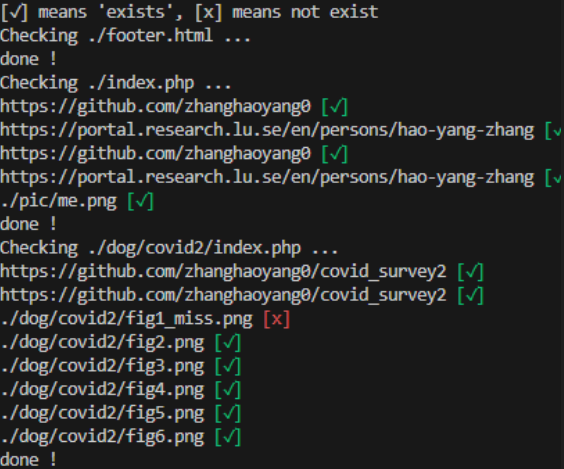
Reverse proxy
frp to access local server using public server (with public IP). In both local and public server:wget -c https://github.com/fatedier/frp/releases/download/v0.57.0/frp_0.57.0_linux_amd64.tar.gz tar -xvf frp_0.57.0_linux_amd64.tar.gz mkdir /usr/local/frp/ sudo mv frp_0.57.0_linux_amd64/* /usr/local/frp/In public server,
frps binary is used. frps.toml is configuration. Most simple setting for frps.toml:
bindAddr = "0.0.0.0" bindPort = 7000In local server,
frpc binary is used. frpc.toml is configuration. Most simple setting for frpc.toml:
serverAddr = "x.x.x.x" # replace it with public IP of public server serverPort = 7000 [[proxies]] name = "ssh" type = "tcp" localIP = "y.y.y.y" # replace it with local IP of local server localPort = 22 remotePort = 6000In public server:
/usr/local/frp/frps -c /usr/local/frp/frps.tomlIn local server:
/usr/local/frp/frpc -c /usr/local/frp/frpc.tomlThen you can visit local server in your public server ("local_name" is the user name in your local server):
ssh -oPort=6000 "local_name"@x.x.x.x(Optional) Use
systemctl to keep both frps and frpc continuous working.
For example, in public server, creat /usr/lib/systemd/system/frp.service:
[Unit] Description=The nginx HTTP and reverse proxy server After=network.target remote-fs.target nss-lookup.target [Service] Type=simple ExecStart=/usr/local/frp/frps -c /usr/local/frp/frps.ini # replace frps with frpc in local server KillSignal=SIGQUIT TimeoutStopSec=5 KillMode=process PrivateTmp=true StandardOutput=syslog StandardError=inherit [Install] WantedBy=multi-user.targetThen:
sudo systemctl daemon-reload sudo systemctl start frpUpdate: now I prefer cloudflare tunnel because it's more stable than frp ...